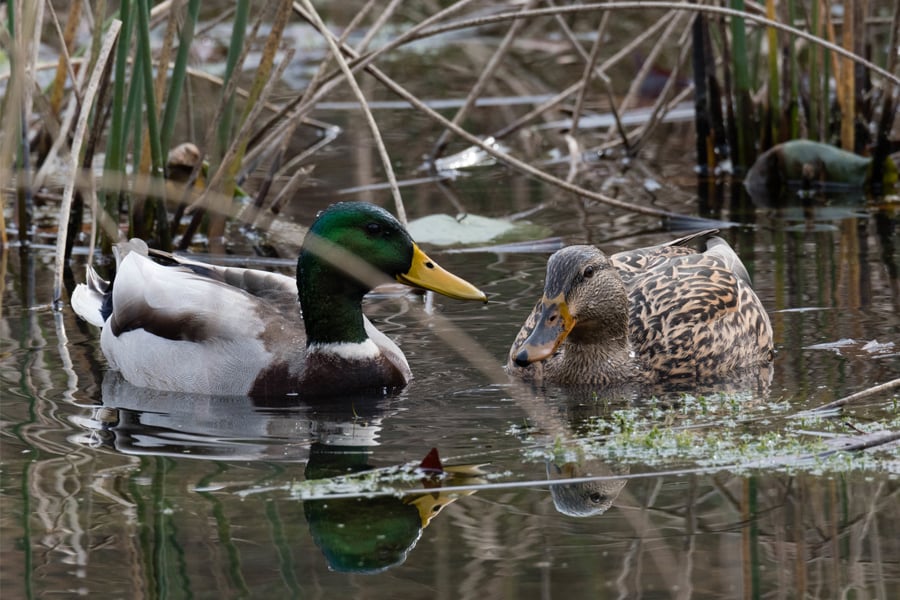Living With Mallards and Geese
This page provides problem-solving advice and ways to make your yard less attractive to mallards and geese in the first place.

Male (left) and female mallards

canada geese
Mallards
Mallards are the most common ducks in DuPage County. They live in wetlands, rivers and lakes as well as retention basins, swimming pools and garden ponds. They may migrate in fall but can stay north year-round if mild temperatures keep waters open.
Mallards may pair up in the fall, but once the female starts to incubate her eggs in spring, the male leaves, often to mate with another. Females usually have one brood a year, which they raise on their own. They lead their ducklings to water 24 hours after the last eggs hatch — a trip that can be over a mile long. Young can fly 40 to 60 days later.
Adult mallards molt in early spring and late summer, although, during the latter, they lose all of their feathers in a short time, which leaves them unable to fly — and vulnerable to predators — for three to four weeks.
Mallards are “dabbling” ducks. Instead of diving for food, they feed by dipping their bills in the water, sometimes upending their entire bodies in the process. They eat a variety of aquatic sedges, grasses, seeds, roots and tubers but will forage on land for grasses and agricultural seeds and grains. Their diet also includes insects, snails, worms, fish and crustaceans, especially during the breeding season.
In summer, high temperatures and low, stagnant waters in ponds and lakes can create ideal breeding grounds for the bacterium that causes botulism. Isolated outbreaks of botulism among mallards may occur, and affected ducks often die within 48 hours.
Canada Geese
Manicured lawns, retention ponds, business campuses and golf courses provide excellent habitat for Canada geese. They often build nests on the ground near water, especially in low-lying areas prone to flooding, but also nest on rocky ledges, above muskrat or beaver lodges, or in parking lots. Like mallards, they can migrate in fall but will stay year-round if waters remain open.
Canada geese mate for life and usually arrive at breeding grounds as mated pairs. Eggs hatch in May, and goslings are able to leave the nest within 24 hours. They remain with their parents until fall, following them to their wintering grounds. Depending on the time of year, a flock can consist of families or groups of families.
From late June to late July, Canada geese lose their flight feathers and their ability to fly. They can be aggressive during this time if they feel their nests or young are threatened and may hiss at or chase people who get too close.
Canada geese will dabble in shallow water for food, but they’re primarily ground feeders, preferring grasses and sedges in spring and summer, berries, seeds and agricultural grains in fall and winter, and lawns year-round.
If You Find a Baby Goose
Young waterfowl can get separated from their families on their way to water after they hatch. Here are some steps you can take if you find a stray gosling.
- Find the original family, or find water that has a family with young around the same size.
- Distract the parents.
- Place the gosling near the other young.
- Walk away and observe from a distance to see if the young are accepted.
Separated goslings need to rejoin their families or join foster families within 24 hours. It’s always best to have ducklings and goslings raised by their own species, but if this is not possible, the DuPage Wildlife Conservation Center will accept them for captive rearing.
Feeding Ducks & Geese
It may seem harmless, but feeding ducks and geese can create serious problems.
The food that people feed ducks and geese is less nutritious than food found in the wild. It can also cause serious digestive problems and make the animals more susceptible to diseases such as avian cholera, duck plague and avian botulism, which can kill large numbers of waterfowl.
-
Handouts bring unnaturally large numbers of ducks and geese into small, concentrated areas, which means that diseases spread more quickly than under normal circumstances, when birds are more spread out.
-
Handouts can lead to overpopulation and excessive amounts of grazing and droppings, which can damage parks, forest preserves, golf courses and lawns. Excessive droppings also add unnaturally high levels of nutrients to ponds and lakes, which can create noxious algal blooms in summer that can kill large numbers of fish.
How to Make Your Yard Less Attractive
- Never feed ducks or geese.
- Keep the ground below bird feeders clean.
- Place inflated beach balls in your yard, and let them blow around, or use deterrents such as motion-activated sprinklers.
- To deter geese, landscape open spaces and the perimeters of ponds with native shrubs and tall grasses. Geese do not like areas with obstructed views where predators can hide.
What You Should Never Do
All native birds, a category that includes mallards and Canada geese, are protected by the 1918 Migratory Bird Treaty Act. It is illegal to:
- Possess birds, dead or alive, or their nesting materials, eggs, feathers or bones without proper permits from the U.S. Fish and Wildlife Service and the state of Illinois.
- Harm or kill a native bird.
- Remove or destroy nesting material once a bird has laid an egg.
- Move young from a nest.
The law does not protect nonnative pigeons (rock doves), English house sparrows or European starlings.
Public Health Concerns
Ducks and geese are not public health concerns, but always use gloves or a shovel to clean up droppings.